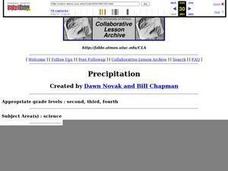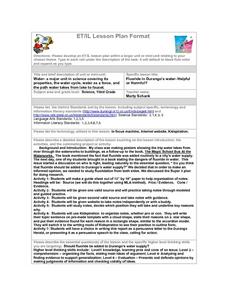Curated OER
Activity #17 Liquid Density and Temperature
Learners comprehend that hot water rises up through cold water but cold water does not rixe in hot water. They comprehend that water at temperatures above 4oC decreases in density with increases in temperature. Students answer lab...
Curated OER
Plant Activities: To Dye For
Students use natural plant dyes to color their clothing as they did in the past.
Curated OER
Water Cycle in a Bag
Students participate in a hands-on activity that demonstrates how the water cycle functions. Students look specifically at condensation and evaporation during the recycling of water.
Curated OER
Living in Water
Fourth graders perform a lab activity in which they examine the external structure of a preserved fish and find out why fish can survive and live in water. They perform a lab which is guided by a worksheet imbedded in this plan.
Curated OER
Precipitation - Pot of Ice/Pot of Boiling Water Experiment
Students observe an experiment where a pot of ice is held over a pot of boiling water. They predict what will happen and then share what they see as the experiment takes place. Then the concept of condensation and precipitation is...
Curated OER
Fluoride in Durango's Water-Helpful or Harmful?
Third graders complete several activities in their quest to find out about the addition of fluoride to city water. First, they create a guide sheet to help organize notes. The next two steps involve taking notes through guided practice....
Curated OER
Active Reading
Students participate in an activity to help them remember their alphabet. They write letters out of plaster and walk through the woods identifying different objects that begin with each letter.
Curated OER
Michigan Quarter Reverse: A Coin Out of Water
Students examine the Michigan quarter reverse and differentiate between bodies of water. On copies of the quarter reverse, they color the land green and the water blue. After observing photos of water bodies, they complete a worksheet...
Curated OER
Exploration Watershed
Students discuss what a watershed is, and locate watersheds on a map. In this watershed lesson plan, students use the information they have been introduced to and create a color coded watershed map of their own.
Curated OER
Other Activities -- Rainbow Fish
Students are read "The Rainbow Fish" and discuss characteristics of being a good friend. They create their own fish to show the qualities they discussed. They receive one scale to add to the fish.
Curated OER
What's a Map
In this mapping activity worksheet, learners color the pictures and then cut them out. Students paste the pictures into the correct map section of city, water, land, and roads.
Curated OER
What is a Globe?
In this globe worksheet, students read a definition of a globe and identify the North Pole. Students color the globe to illustrate the land and water.
Curated OER
The Solar System: Why do we Explore?
Third graders act as scientists. In this property discovery lesson, 3rd graders explore the substance "Oobleck" (cornstarch, water, food coloring). They work in groups to investigate the substance and make observations as a scientist...
Curated OER
Letter A Alligator Theme
Students complete a variety of activities related to the letter A. They trace the letter A on a worksheet, paint the letter A, create an apple print painting, cut out and glue magazine pictures of things starting with the letter A, and...
Curated OER
Cool Activities: Make Slime
Students analyze chemistry by conducting an in-class experiment. In this slime instructional activity, students discuss what slime is and what form of matter it qualifies as. Students utilize borax, glue, water, cups, food coloring and...
Curated OER
Locating the Salt Front - Section 1
For this salt front of the Hudson River worksheet, 7th graders first read an excerpt about the lower portion of the Hudson River that is an estuary. Then they use a colored pencil to plot salinity data from the table shown on a graph,...
Curated OER
Tracking a Virus
Students simulate the spread of a virus such as HIV through a population by "sharing" (but not drinking) the water in a plastic cup with several classmates. Although invisible, the water in a few of the cups will already be tainted with...
Curated OER
Who Eats Who?
Students recognize that some animals eat plants, some eat meat and some both. For this who eats who lesson, students chart animals in a food chain. Students research information from reading articles. Students chart what animals eat...
Teach Engineering
Bubbles and Biosensors
Bubbles aren't just for children. In the third installment of a seven-part series, teenagers use bubble solution to create bubbles and observe patterns of refraction on the bubble surfaces. Application of this concept to thin films in...
National Park Service
It Was a Very Good Year
Waterton-Glacier International Peace Park includes whitebark pines that are over 1,200 years old, meaning they have been there since before medieval times. The second lesson of five details how to read tree rings for climate change and...
Curated OER
Art: Drawing Ducks in Their Natural Habitats
Sixth graders explore various waterfowl species and discover how duck stamps are used. After researching specific types of birds for a stamp competition, they draw the birds in various natural settings. Before sending the submissions,...
Curated OER
Mixing Colors
In this science learning exercise, learners drop food coloring into a glass of water. Students mix different colors to create new colors.
Curated OER
Swirling and Churning Milk
Students examine the concepts of micelles, polarity, solubility, and properties of detergent in an experiment with milk, water, and food coloring. Students complete a Take-Home Challenge in which they experiment with the behavior of food...
Curated OER
Exploring Caves
Students explore the various characteristics of caves. Through class discussion and hands on activities, students identify what forces converge in the creation of a cave. They complete review activities at the conclusion of the lesson...

























